SpringBoot开始定时任务的三种方式
spring boot进行定时任务一共有三种方式,第一种也就是最简单的一种:基于注解 (@Scheduled)的方式;第二种:基于接口 (SchedulingConfigurer);第三种:基于注解设定多线程定时任务。
一、基于注解的方式
首先,打开idea,创建springboot项目,无需引入任何jar,springboot自带定时。
然后在启动类中用注解@EnableScheduling进行标注,表明此类存在定时任务。在定时任务执行的方法之上添加注解
@Scheduled(cron ="*/6 * * * * ?")。启动类:
package com.example.demo;
import org.springframework.boot.SpringApplication;
import org.springframework.boot.autoconfigure.SpringBootApplication;
import org.springframework.scheduling.annotation.EnableScheduling;
import org.springframework.scheduling.annotation.Scheduled;
@SpringBootApplication
@EnableScheduling
public class DemoApplication {
public static void main(String[] args) {
SpringApplication.run(DemoApplication.class, args);
}
@Scheduled(cron ="*/6 * * * * ?")
public void sayHello() {
System.out.println("hello");
}
}点击启动,即可看到控制台6秒输出一次“hello”
当然,定时任务也可以放在其他类中,例如创建类Task1
package com.example.task;
import org.springframework.scheduling.annotation.Scheduled;
import org.springframework.stereotype.Component;
/**
* @Description
* @ClassName Task1
* @Author User
* @date 2020.06.07 12:24
*/
@Component
public class Task1 {
@Scheduled(cron ="*/1 * * * * ?")
public void sayWord() {
System.out.println("world");
}
}
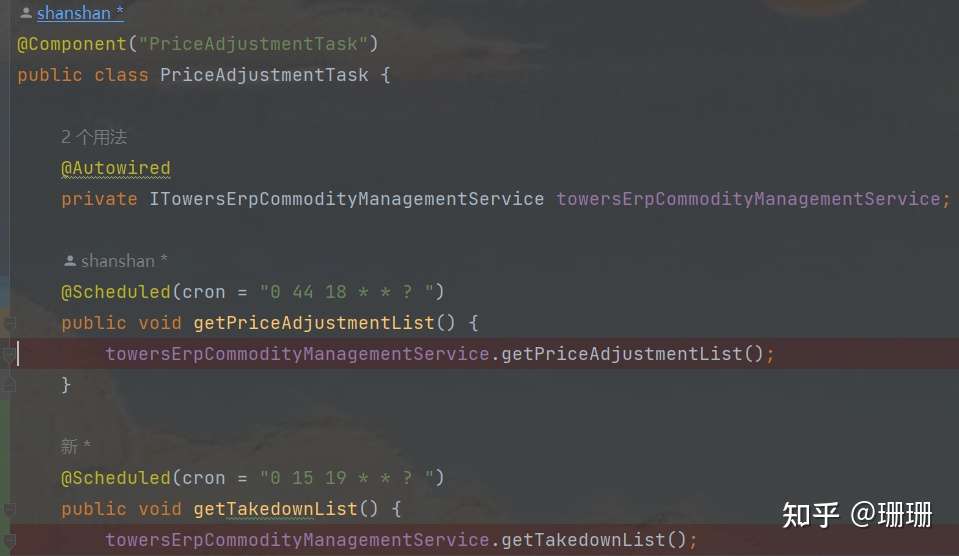
注意细节:就是启动类需要能扫描到定时任务类,否则定时任务启动不起来。不仅需要@Component注解,也需要将启动类位置位于定时任务之上。
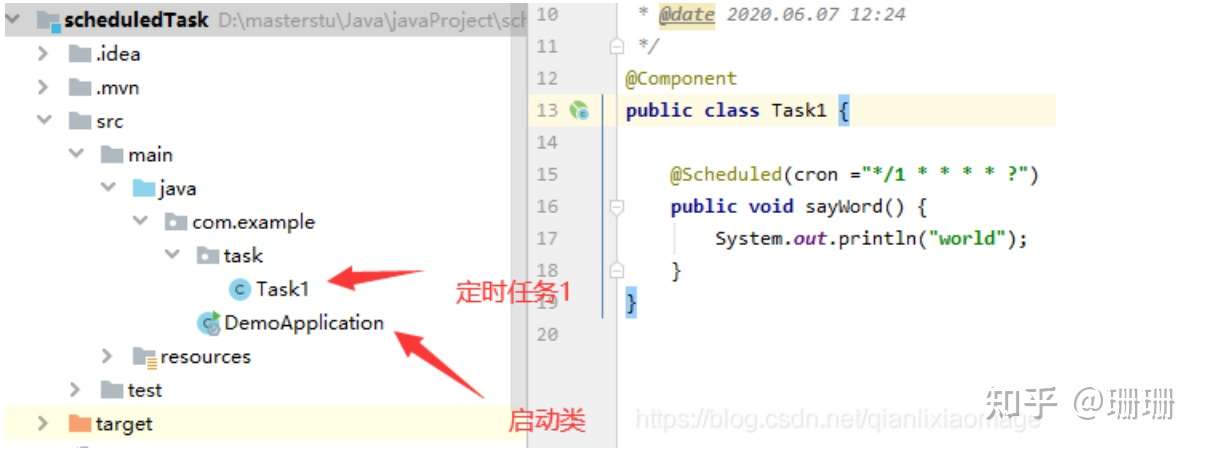
@Scheduled除过cron还有三种方式:fixedRate,fixedDelay,initialDelay
cron:表达式可以定制化执行任务,但是执行的方式是与fixedDelay相近的,也是会按照上一次方法结束时间开始算起。
fixedDelay:控制方法执行的间隔时间,是以上一次方法执行完开始算起,如上一次方法执行阻塞住了,那么直到上一次执行完,并间隔给定的时间后,执行下一次。
@Configuratio
@EnableScheduling //开启定时任务
public class ScheduleTask1 {
//每3秒执行一次
@Scheduled(fixedDelay = 3000)
private void myTasks() {
System.out.println("I do myself per third seconds");
}
}fixedRate:是按照一定的速率执行,是从上一次方法执行开始的时间算起,如果上一次方法阻塞住了,下一次也是不会执行,但是在阻塞这段时间内累计应该执行的次数,当不再阻塞时,一下子把这些全部执行掉,而后再按照固定速率继续执行。
@Component
@EnableScheduling //开启定时任务
public class ScheduleTask2 {
//每10秒执行一次
@Scheduled(fixedRate = 10000)
private void myTasks2() {
System.out.println("我是一个定时任务");
}
initialDelay:initialDelay = 10000 表示在容器启动后,延迟10秒后再执行一次定时器。
@Component
@EnableScheduling //开启定时任务
public class ScheduleTask {
//容器启动后,延迟10秒后再执行一次定时器,以后每10秒再执行一次该定时器。
@Scheduled(initialDelay = 10000, fixedRate = 10000)
private void myTasks3() {
System.out.println("我是一个定时任务3");
}
二、cron解释
cron
cron用法跟linux下是一模一样的,如果你搞过linux下的定时,那么必然很熟悉
结构
cron表达式是一个字符串,分为6或7域,每两个域之间用空格分隔;
其语法格式为:“秒域 分域 时域 日域 月域 周域 年域”
取值范围

常例
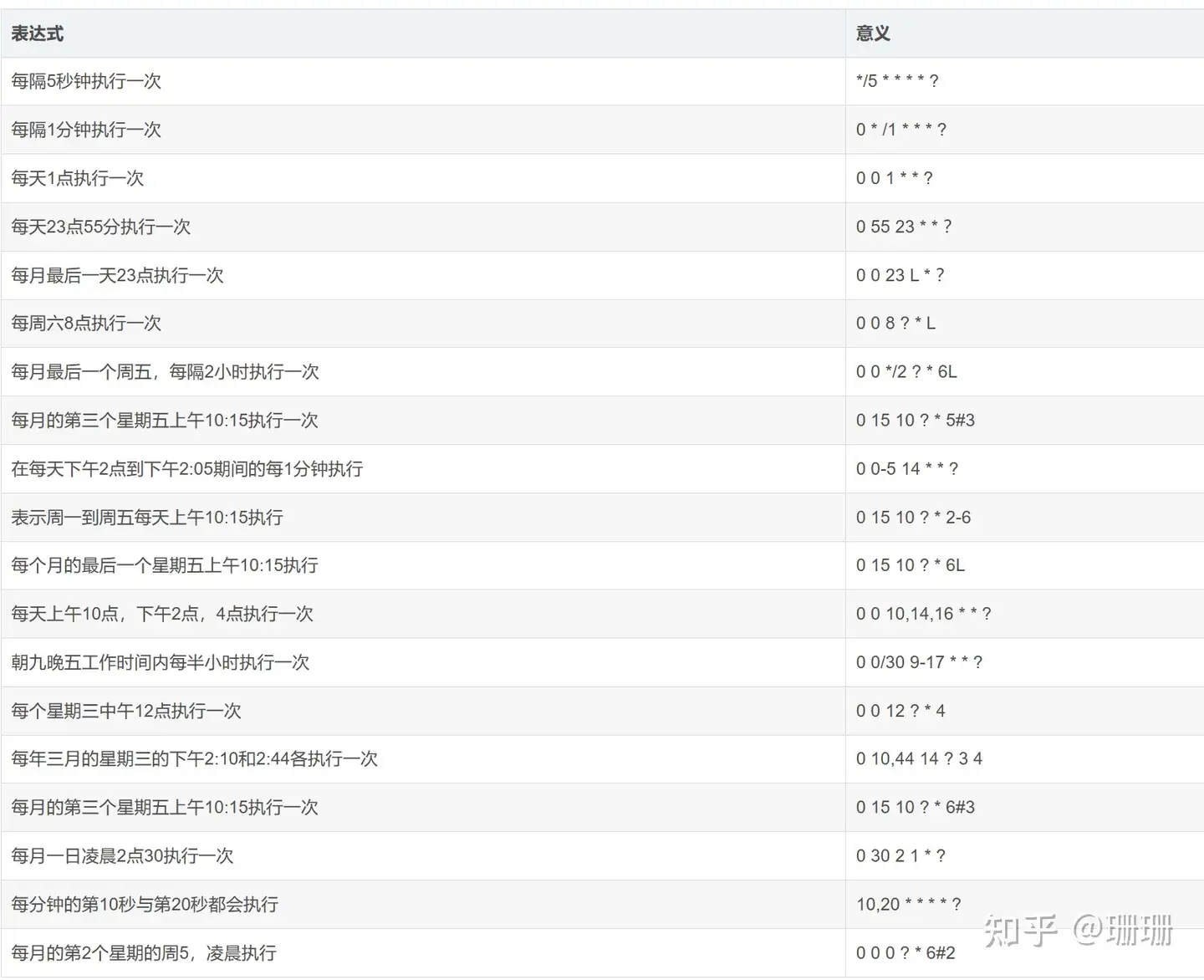
三、基于接口的方式
使用 @
注解很方便,但缺点是当我们调整了执行周期的时候,需要重启应用才能生效,多少有些不方便。为了达到实时生效的效果,那么可以使用接口来完成定时任务,统一将定时器信息存放在数据库中
在mysql中执行一下脚本插入定时任务
drop table if exists `scheduled`;
create table `scheduled` (
`cron_id` varchar(30) NOT NULL primary key,
`cron_name` varchar(30) NULL,
`cron` varchar(30) NOT NULL
);
insert into `scheduled` values ('1','定时器任务一','0/6 * * * * ?');创建一个springboot 项目:我们这里只添加一个mapper,不要bean也不要service以及controller,只是为了演示定时功能而已。demo结构:
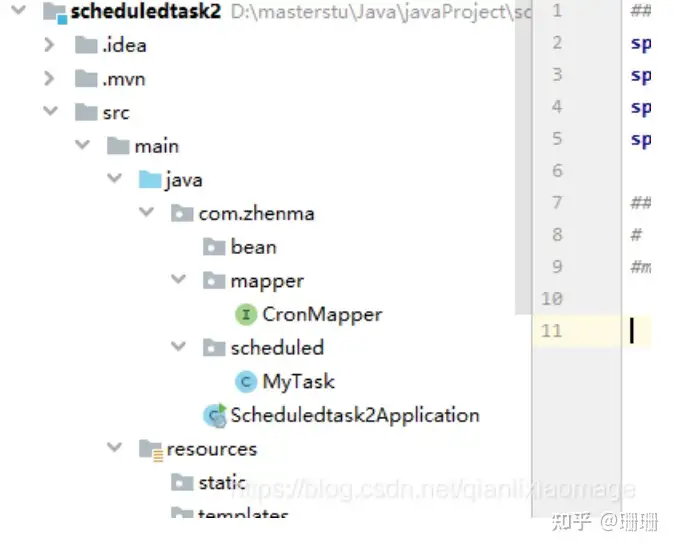
数据源基本配置:application.properties
## mysql数据源配置
spring.datasource.url=jdbc:mysql://host:3306/dbname?useUnicode=true&serverTimezone=Asia/Shanghai
spring.datasource.username=root
spring.datasource.password=123456
spring.datasource.driver-class-name=com.mysql.cj.jdbc.Driver
## Mybatis 配置
# 配置为 com.example.bean 指向实体类包路径
#mybatis.typeAliasesPackage=com.zhenma.bean
mapper也就是dao:
package com.zhenma.mapper;
import org.apache.ibatis.annotations.Mapper;
import org.apache.ibatis.annotations.Select;
import org.springframework.stereotype.Repository;
@Repository
@Mapper
public interface CronMapper {
@Select("select cron from scheduled where cron_id = #{id}")
public String getCron(int id);
}task类:
package com.zhenma.scheduled;
import com.zhenma.mapper.CronMapper;
import org.springframework.beans.factory.annotation.Autowired;
import org.springframework.scheduling.annotation.EnableScheduling;
import org.springframework.scheduling.annotation.SchedulingConfigurer;
import org.springframework.scheduling.config.ScheduledTaskRegistrar;
import org.springframework.scheduling.support.CronTrigger;
import org.springframework.stereotype.Component;
/**
* @Description
* @ClassName MyTask
* @Author User
* @date 2020.06.07 15:23
*/
@Component
@EnableScheduling
public class MyTask implements SchedulingConfigurer {
@Autowired
protected CronMapper cronMapper;
@Override
public void configureTasks(ScheduledTaskRegistrar scheduledTaskRegistrar) {
scheduledTaskRegistrar.addTriggerTask(() -> process(),
triggerContext -> {
String cron = cronMapper.getCron(1);
if (cron.isEmpty()) {
System.out.println("cron is null");
}
return new CronTrigger(cron).nextExecutionTime(triggerContext);
});
}
private void process() {
System.out.println("基于接口定时任务");
}
}
从结果中可以看出,是按照每6秒也就是数据库中查询的结果来进行的
需求:我现在需要每10秒执行一次定时任务,该怎么办呢?对!只需要修改数据库值即可,server无需重启。观察修改后的结果。
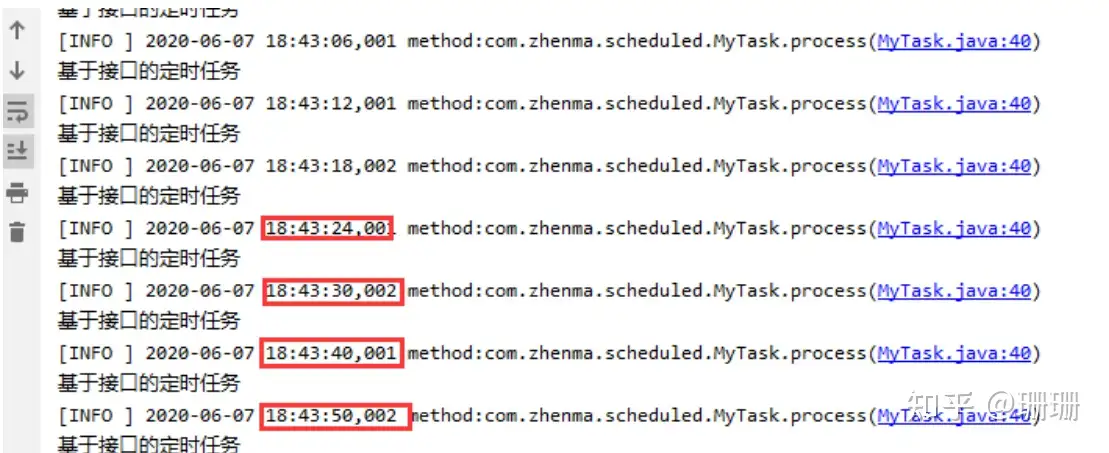
四、 基于注解设定多线程定时任务
@Scheduled执行周期任务会受到上次一个任务的执行时间影响。那么可以开启多线程执行周期任务
创建springboot项目,创建一个多线程定时任务类如下:
package com.example.task;
import org.springframework.scheduling.annotation.Async;
import org.springframework.scheduling.annotation.EnableAsync;
import org.springframework.scheduling.annotation.EnableScheduling;
import org.springframework.scheduling.annotation.Scheduled;
import org.springframework.stereotype.Component;
import java.time.LocalDateTime;
/**
* @Description
* @ClassName MultiThreadTask
* @Author User
* @date 2020.06.07 18:56
*/
@EnableScheduling // 1.开启定时任务
@EnableAsync // 2.开启多线程
@Component
public class MultiThreadTask {
@Async
@Scheduled(fixedDelay = 1000) //间隔1秒
public void first() throws InterruptedException {
System.out.println("第一个定时任务开始 : " + LocalDateTime.now().toLocalTime() + "\r\n线程 : " + Thread.currentThread().getName());
Thread.sleep(1000 * 10);
}
@Async
@Scheduled(fixedDelay = 2000)
public void second() {
System.out.println("第二个定时任务开始 : " + LocalDateTime.now().toLocalTime() + "\r\n线程 : " + Thread.currentThread().getName());
}
}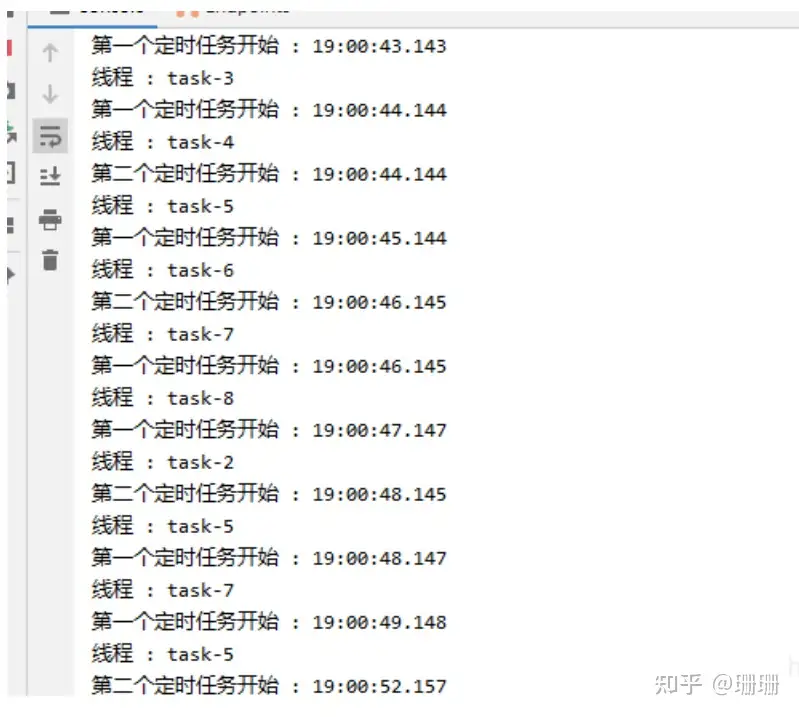
从结果可以看出:第一个任务的执行时间也不受其本身执行时间的限制。两个任务也互不影响






 浙公网安备 33010602011771号
浙公网安备 33010602011771号